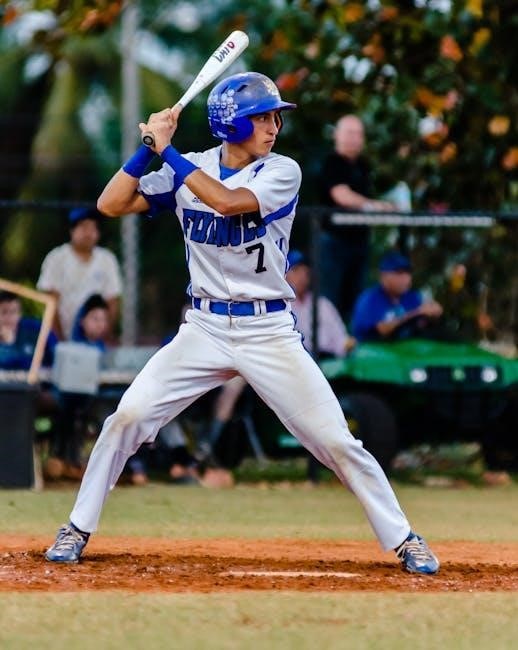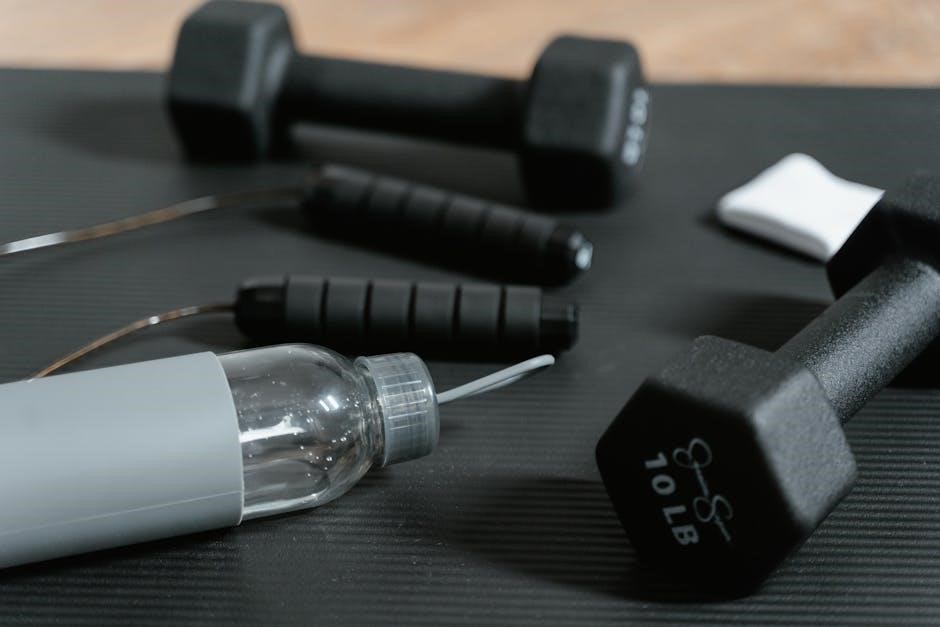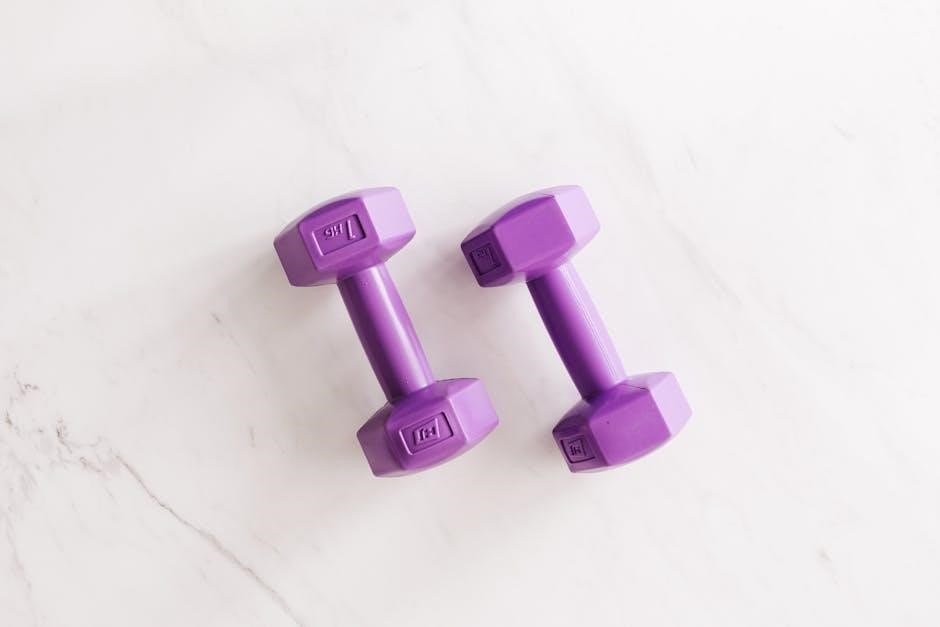A well-structured baseball weight training program enhances strength, power, and endurance, tailored to pre-season, in-season, and off-season phases, ensuring peak performance and injury prevention.
Overview of the Importance of Strength Training in Baseball
Strength training is a cornerstone of baseball performance, enhancing power, speed, and endurance while reducing injury risk. It improves bat speed, throwing velocity, and explosiveness, critical for hitting, pitching, and fielding. A strong foundation boosts stability and longevity, allowing players to maintain peak performance throughout the season. Properly designed programs address specific muscle groups, ensuring balanced development. Strength training also enhances recovery, enabling athletes to handle the demands of practice, games, and travel. For both position players and pitchers, a well-executed strength program is essential for achieving and sustaining success at all levels of competition, from youth leagues to professional play.
Key Components of a Baseball Weight Training Program
A comprehensive baseball weight training program includes compound movements like squats, deadlifts, and bench presses to build overall strength. Power-focused exercises such as power cleans and weighted lunges enhance explosiveness. Core and stability work, including pull-ups, push-ups, and shoulder raises, improve balance and durability. The program is periodized into pre-season, in-season, and off-season phases, each with specific goals. Progression and overload are achieved by safely increasing load and volume, while monitoring athlete progress ensures optimal adaptation. Proper form, medical clearance, and personalized adjustments are essential to maximize effectiveness and prevent injuries, creating a balanced and effective training regimen tailored to baseball demands.

Periodization of Baseball Weight Training

Periodization structures training into phases, focusing on building strength, power, and endurance during pre-season, maintaining performance in-season, and recovering post-season for sustained success and injury prevention.
Pre-Season Training: Building a Foundation
Pre-season training focuses on establishing a strong base of strength and endurance. This phase typically lasts 16-20 weeks, emphasizing high-volume, low-to-moderate weight exercises to build muscle and improve overall athleticism. Athletes engage in compound movements like squats, deadlifts, and bench presses to enhance power and stability. Auxiliary exercises such as pull-ups, push-ups, and shoulder raises are also incorporated to target specific muscle groups. The goal is to gradually increase load and volume, ensuring proper form and technique to minimize injury risk. This foundational work prepares players for the demands of the upcoming season, improving speed, agility, and rotational power essential for baseball performance.
In-Season Training: Maintaining Strength and Power
In-season training focuses on maintaining the strength and power developed during the pre-season while balancing game demands. Typically lasting 16-20 weeks, this phase involves 3 strength sessions per week, with optional speed and agility work. The program emphasizes lower volume and varied loads, often below 80% of an athlete’s max, to avoid overtraining. Key exercises include power cleans, weighted lunges, and core work to preserve explosiveness and stability.Active recovery techniques, such as foam rolling and stretching, are integrated to aid muscle maintenance. The goal is to sustain performance levels without compromising in-game execution, ensuring players remain fresh and injury-resistant throughout the season.
Post-Season (Off-Season) Training: Recovery and Progression
The post-season phase focuses on recovery and progressive overload to enhance overall strength and power. This period typically lasts 16-20 weeks, beginning with active recovery to address muscle fatigue and prevent injury. Initial training involves high volume and lighter weights, progressing to more intense loads as the phase advances. Emphasis is placed on compound movements like squats and deadlifts, alongside power exercises such as power cleans and weighted lunges. Core and stability work, including pull-ups and push-ups, are also prioritized to build a strong foundation. Active recovery techniques, such as stretching and foam rolling, are integrated to maintain flexibility and muscle health. The goal is to rebuild and improve strength, setting a solid base for the upcoming season.
Baseball-Specific Exercises for Weight Training
Baseball-specific exercises target strength, power, and endurance, focusing on compound movements, power exercises, and core work to enhance performance and durability for the sport’s demands.
Compound Movements: Squats, Deadlifts, and Bench Press
Compound movements like squats, deadlifts, and bench presses are foundational in baseball weight training, building overall strength and stability. Squats enhance lower body power, essential for explosive movements like sprinting and jumping. Deadlifts improve full-body strength and core stability, crucial for maintaining proper posture and generating force during swings or throws. The bench press targets the upper body, including the chest, shoulders, and triceps, which are vital for batting power and throwing velocity. These exercises are often performed with progressive overload to increase strength and muscle mass, adhering to guidelines like bench pressing 1.5x bodyweight, squatting 2x, and deadlifting 2.5x. They form the cornerstone of a baseball weight training program, ensuring athletes develop the strength needed for peak performance.
Power and Explosiveness: Power Cleans and Weighted Lunges

Power cleans and weighted lunges are essential for developing the explosive strength and speed required in baseball. Power cleans involve explosive, dynamic movements that mimic the quick bursts of energy needed for actions like stealing bases or reacting to a pitch. They build power in the hips, legs, and core, translating directly to batting and fielding. Weighted lunges, on the other hand, improve lower body stability and balance while enhancing the ability to generate force from a single leg, crucial for base running and quick changes of direction. Both exercises are integral to a baseball weight training program, helping athletes achieve the power and agility necessary for competitive play.
Core and Stability: Pull-Ups, Push-Ups, and Shoulder Raises
Core and stability exercises like pull-ups, push-ups, and shoulder raises are critical for baseball players, as they enhance overall athleticism and injury prevention. Pull-ups strengthen the latissimus dorsi muscles, improving grip strength and power for batting and throwing. Push-ups target the chest, shoulders, and triceps, building endurance and stability in the upper body. Shoulder raises focus on shoulder stability and rotational strength, essential for pitching and fielding. These exercises improve posture, balance, and core rigidity, allowing players to maintain proper mechanics during dynamic movements. Incorporating these into a baseball weight training program ensures a strong, injury-resistant foundation, enabling athletes to perform at their best throughout the season.

Progression and Overload in Baseball Weight Training
Progression and overload involve systematically increasing weight or volume to build strength and power, ensuring safe advancement to optimize performance and prevent injury in baseball athletes.
Increasing Load and Volume Safely
Increasing load and volume safely is crucial for continuous progress in baseball weight training. This involves gradual progression of weights, reps, or sets based on athlete readiness. A well-structured periodized program ensures athletes avoid plateaus and injuries. For example, starting with lower weights and higher reps in the pre-season builds a foundation, while transitioning to heavier loads and lower reps in-season maintains strength. Monitoring progress through strength assessments and technique checks ensures safe overload. Exercises like squats, deadlifts, and bench presses are key for building overall strength, while power cleans and lunges target explosiveness. Coaches must balance intensity with recovery to optimize performance and prevent overtraining.
Monitoring Athlete Progress and Adjusting Programs
Monitoring athlete progress is essential for optimizing baseball weight training programs. Coaches use strength assessments, performance metrics, and recovery feedback to evaluate progress. Adjustments are made to ensure continued improvement and prevent overtraining. For example, if an athlete plateau in their squat or deadlift, loads or volumes are modified. Power exercises like cleans and lunges are tweaked to enhance explosiveness. Recovery techniques, such as mobility drills, are incorporated to maintain athlete health. Periodized programs allow for phased adjustments, ensuring athletes peak during the season. Regular communication between athletes and coaches fosters a tailored approach, maximizing gains while minimizing injury risks. This adaptive process ensures programs remain effective and aligned with athlete goals.
Weight training is a cornerstone of modern baseball success, enhancing strength, power, and endurance while reducing injury risks. A well-structured program tailored to pre-season, in-season, and off-season phases ensures athletes maintain peak performance. Exercises like squats, deadlifts, and power cleans build foundational strength, while explosive movements improve bat speed and throwing velocity. Monitoring progress and adjusting programs based on athlete feedback and performance metrics optimize results. The integration of recovery techniques and periodized training fosters long-term development. Ultimately, a comprehensive weight training program is essential for achieving and sustaining excellence in baseball, empowering players to perform at their best when it matters most.
